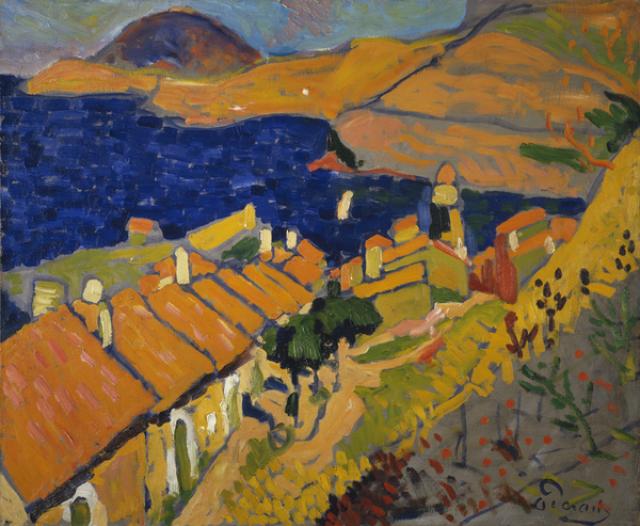Fauvism
A group of painters in France in the early 20th century, including Henri Matisse and André Derain, who used bold, vivid colours in their work. The name is derived from a derogatory remark from a critic who saw them as akin to wild beasts.

A group of painters in France working between 1905 and 1908, including Henri Matisse, André Derain and Maurice Vlaminck, who used bold, vivid colours in their work. The name is derived from a derogatory remark made by a critic, who saw them as akin to ‘les fauves’, or ‘the wild beasts.’
Early Origins
The Fauvist style emerged out of Neo-Impressionism in around 1899, as influenced by the vivid colours and expressive tendencies of artists including Paul Gauguin, Vincent van Gogh and Edvard Munch. The Symbolist painter Gustav Moreau was a highly influential teacher, whose belief that colour, form and content in art should invoke emotional states and many of his former students would pursue the Fauvist style. However, where Symbolists veered towards melancholia, the Fauvists were more optimistic.
Matisse, Derain and Vlaminck
Although one of the most prominent movements of the 20th century, the Fauvists were never an organised group with a specific agenda, formed instead from a loosely affiliated group of friends, students and artists who shared ideas. The most prominent members to arise were Henri Matisse, Andre Dérain and Maurice Vlaminck, while others associated with the style included Henri-Charles Manguin, Raoul Dufy and Georges Rouault.
Matisse is often cited as the leader of the Fauvist style and referred to as ‘the king of the wild beasts.’ His iconic painting Luxe, Calme et Volupte (Luxury, Calm and Pleasure), 1904 (Musée d'Orsay, Paris), has been heralded as one of the first truly Fauvist paintings, with its flattened colours, strong contours and celebratory tone. Matisse met Derain in 1899 and in 1901, and through Derain he was introduced to Vlaminck. As their elder, Matisse was an encouraging mentor to the younger two artists. In the summer of 1905 Matisse invited Derain to join him at the small French Mediterranean fishing port of Collioure, where the two spent four hugely prolific months living and working together, producing some of the most significant Fauvist paintings, including Derain’s Collioure, 1905. Of the fauvist style he and Matisse developed together Derain wrote, ‘Colours became charges of dynamite. They were supposed to discharge light. Everything could be raised above the real.’
The ‘Wild Beasts’
In the Autumn of 1905 Matisse, Derain and Vlaminck exhibited together at the Salon D’Automne. French art critic Louis Vauxcelles (1870-1943) saw the paintings situated alongside a traditional bust by Marquet, a scene he described as, 'Donatello parmi les fauves' (‘Donatello among the wild beasts’). Although derogatory, the term was proudly accepted by the painters, which they felt aptly described their carefree celebrations of flattened forms, heightened colours and expressive brushstrokes. The deliberate naivety of their painting style attracted criticism initially, seen as crude, childlike and puerile. But their sense of optimism and freedom eventually caught on, and by 1906 the group were seen as most advanced painters in Paris. Subjects varied from portraits, landscapes and figures, but the predominant focus was on vivid, unmixed colour and balanced composition, creating works which veered close to abstraction.
In 1908 Matisse published his Notes of a Painter in La Grande Revue, describing the central fauvist tenets, ‘The chief aim of colour should be to serve expression as well as possible...What I dream of is an art of balance, of purity and serenity devoid of troubling or depressing subject matter, an art which might be for every… worker… like a good armchair in which to rest from physical fatigue.’
Further Developments
Fauvism was a short-lived movement, with members moving in separate directions by 1908. Through the influence of Picasso, Derain moved towards a Cubist style, while Vlaminck veered closer to Expressionism. Matisse, the pioneer, remained true to the Fauvist sensibility for the rest of his career, producing some of the most famous artworks in the world with a riotous celebration of colour, line and form. As a precursor to abstraction Fauvism paved the way for a series of revolutionary art movements, the most prominent being German Expressionism, while the French poet Apollinaire (1880-1918) later described Fauvism’s reductive, flattened forms as ‘a kind of introduction' to Cubism.
